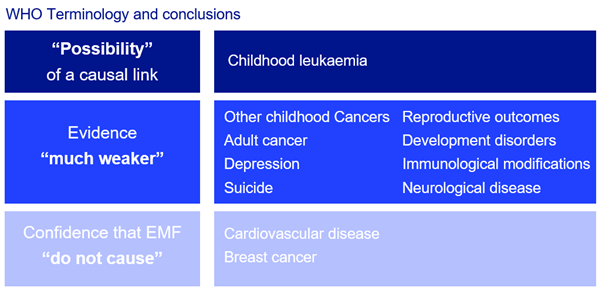Other health effects
There has been a vast amount of research investigating EMFs and various health issues. The main concern has focused on childhood leukaemia but this page summarises the evidence for the other health effects which have been investigated.
An overall comment on health effects other than childhood leukaemia comes from the WHO monograph:
"The scientific evidence supporting a linkage between ELF (extremely low frequency) magnetic fields and any of these diseases is much weaker than for childhood leukaemia and in some cases (for example, for cardiovascular disease or breast cancer) the evidence is sufficient to give confidence that magnetic fields do not cause the disease."
Below is the World Health Organisation’s summary of research into different health outcomes and how they rank that evidence.

Some of the most discussed health effects are noted below, alongside some of the studies conducted into each. There are many papers associated with each topic which can be explored at the EMF-Portal.
The Childhood Cancer Research Group at Oxford University conducted a large study in the UK looking at all childhood cancers in children born in England and Wales between 1962-1995. They identified nearly 33 000 cases of childhood cancer and that study looked to see if there was any associated with proximity to overhead lines. Although the study did find an association with childhood leukaemia, no excess risk in relation to proximity to lines was found for other childhood cancers.
The main neurodegenerative disorders are Alzheimer's disease, Parkinson's disease, and Amyotrophic Lateral Sclerosis (ALS, known in the USA as Lou Gehrig's disease). These have been investigated in both public and occupational settings.
Reviews of the research by ICNIRP concluded:
“The studies investigating the association between low frequency exposure and Alzheimer’s disease are inconsistent. Overall, the evidence for the association between low frequency exposure and Alzheimers disease and ALS is inconclusive.”
The most recent SCHEER review concluded:
“Overall, there is moderate evidence (mainly from human studies) on the association between occupational exposure to ELF-EMF and ALS, weak evidence for the association of occupational ELF-EMF exposure with Alzheimer’s disease, and dementia, but only uncertain to weak evidence for residential exposure and these neurodegenerative diseases. No significant association can be established between EMF exposure and Parkinson's or multiple sclerosis disease.”
Research into neurodegenerative disorders continues. In the UK a large cohort (group) of electricity workers have been examined over decades. This study concluded:
“There is no convincing evidence that UK electricity generation and transmission workers have suffered increased risks from neurodegenerative diseases as a consequence of exposure to magnetic fields.”
There have been a number of epidemiological studies investigating if suicide and depression are associated with EMF exposure. Overall, the results are inconclusive, with ICNIRP stating:
“There is only inconsistent and inconclusive evidence that exposure to low-frequency electric and magnetic fields causes depressive symptoms or suicide.”
This is one area where the WHO have said that the scientific evidence is inadequate and that there is confidence that EMF do not cause reproductive issues. The WHO concluded:
"On the whole, epidemiological studies have not shown an association between adverse human reproductive outcomes and maternal or paternal exposure to ELF fields. There is some evidence for an increased risk of miscarriage associated with maternal magnetic field exposure, but this evidence is inadequate.
Overall, the evidence for developmental and reproductive effects is inadequate."